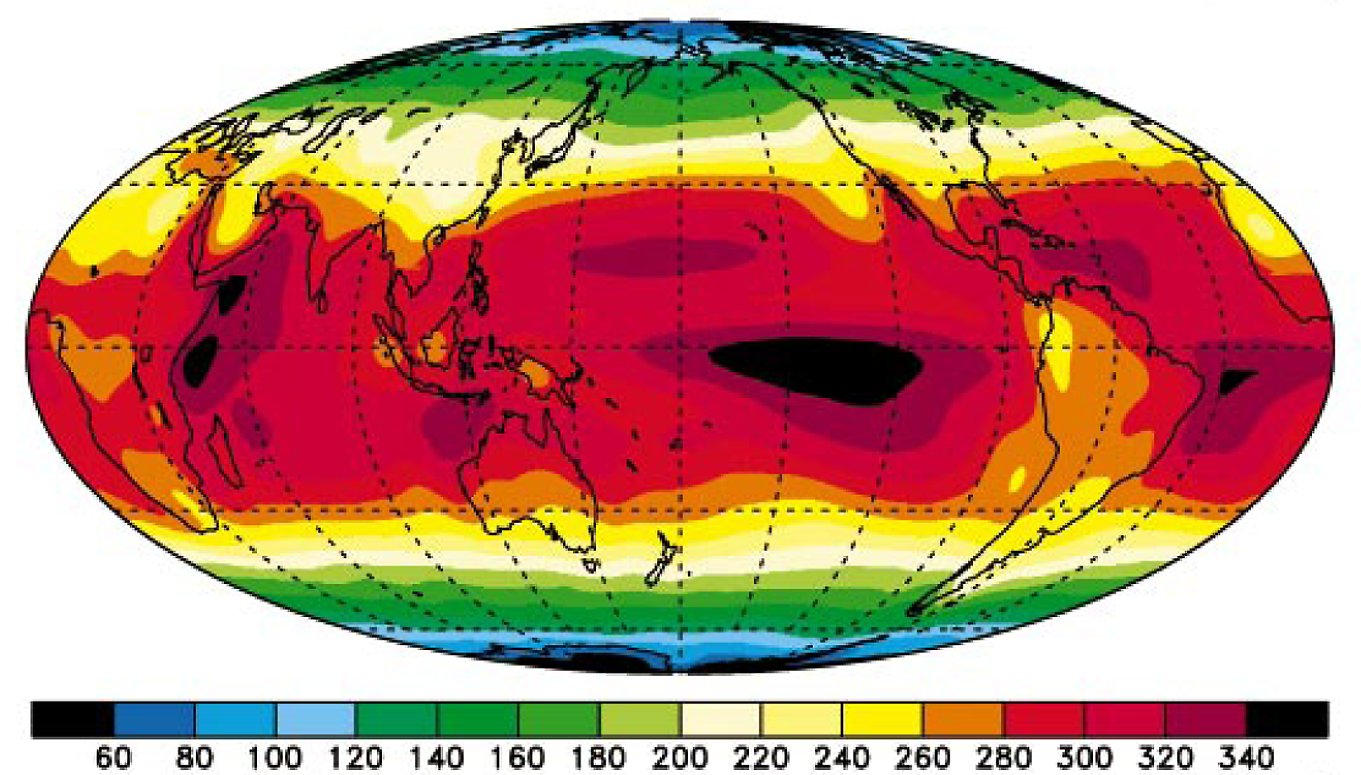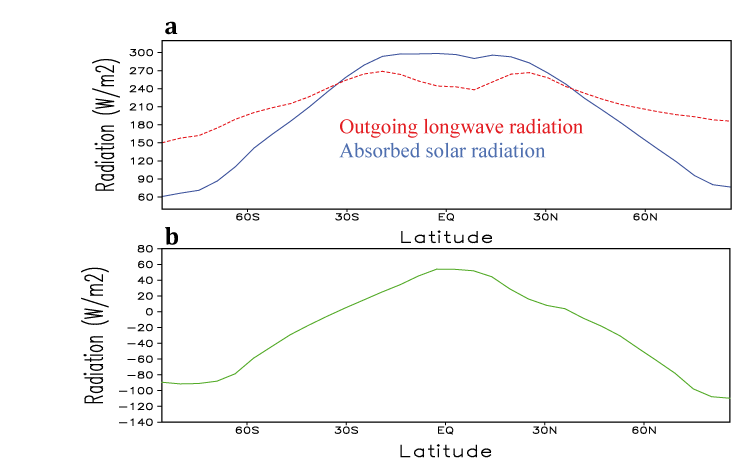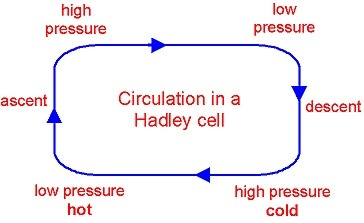Introduction
In all thermal systems, inequities in radiative heating lead to convective or conductive processes in fluid or solid bodies respectively in an effort to evenly distribute heat energy throughout the object. The earth is no exception, and the impetus of myriads of meteorological and oceanological phenomena that exhibit turbulence in this system can often be traced back to attempts of nature to evenly distribute the energy obtained through incident solar radiation.
Conceptual Visualization: The Earth
Figure 1.1: Figure from Trenberth and Stepaniak (2003). Copyright 2003 American Meteorological Society (AMS); http://www.climate.be/textbook/chapter2_node6.html
Figure 1.2: Cumulative sum of incoming and outgoing radiation with respect to latitude. http://www.climate.be/textbook/chapter2_node6.html
Given this, it would be sensible to conclude that thermal energy would be convected away from the equator and towards the poles. As such, the concept of the "Hadley Cell" is introduced, as is visible in Figure 1.3. At its root a horizontal circulation that serves as a "conveyer belt" for thermal energy, significant differences in the cell's behavior can be expected depending on whether or not the fluid is laminar or turbulent.
Figure 1.3: At its simplest, a thematic of a Hadley cell. http://www.elgheko.us/meteo.htm
Theory: Laminar or Turbulent Fluid, and Resultant Atmospheric Effects
Given that air should rise near the equator and sink in the vicinity of the polar regions, in a non-rotating system one would expect the motion of fluid to be purely meridional, towards the poles in the upper levels, and away from the poles and directed equatorially at the surface. However, the earth is a rotating system, with the atmosphere roughly in solid-body rotation. Therefore, we must take this into consideration, and do so using the Coriolis parameter. Because the Coriolis deflection is weakest at the equator and considering that fluid at the equator orbits the globe where its radius is the greatest, its angular momentum is greater than at any other point on earth since the earth is a solid body. Therefore, by the conservation of angular momentum, we would expect that, to conserve momentum, a parcel of air from the equator attempting to move towards the pole would be deflected eastward in direction since its zonal velocity must increase. Therefore, at the upper levels, a westerly jet should form, strongest as one heads away from the equator. For the sinking air later in its poleward journey, the opposite should be true; as it returns towards the equator, its weakening horizontal velocity due to the increase in radius should lead to surface easterly forming, strongest at the equator. This gives rise to the Intertropical Convergence Zone, where both Hadley cells converge. The rising motion here, coupled with the easterly winds (and the subtropical easterly jet, which, due to surface friction, is considerably weaker than other jets) leads to the development of tropical waves, and is an integral portion of cyclone forecasting.
When the Coriolis parameter is low, the fluid will be mainly laminar, and be governed by the physics of the Hadley cell. However, the entire globe cannot exist as a Hadley cell; proof of this can be sought within the Law of Conservation of Angular Momentum. Given that the radius of a parcel's orbit would be zero at the poles, utilizing solely this law would yield infinite winds aloft at those locations. Given that this is quite impossible, we are forced to rely on eddy heat transport, which "takes care of angular momentum" in other ways by breaking down polar heat transport into more localized vortices. This offers at latitudes in the 30-90º regime, where the Coriolis parameter is too great to maintain the laminar nature of the fluid, which results to turbulence. Elsewhere towards the equator, the fluid is largely laminar, leading to Hadley cells becoming the main means of heat transport between 30ºN and 30ºS.
//This is where somebody better than me does their equation magic...
Analogues in the Tank...
Several key differences exist between the earth and our tank experiment; after all, one is a three dimensional rotating sphere comprised of solid, liquid, and gas, complete with pressure gradients amidst the fluid as well as several means of thermal heat fluxes. Meanwhile, the tank is a two-dimensional representation, and the incompressible nature of the fluid leads to further behavioral differences.
At its root a large rotating cylinder about 0.6-0.7 meters in diameter and 0.25 meter tall, the acted as a representation of only one hemisphere. Towards the center of the tank, which one can envision "flattening" as a net against the hemispherical form of either the top of bottom half of the globe, a small bucket of ice was placed. The ice was contained in a metal cup with a low specific heat capacity, which then transferred the cooling effect through conduction to the water closest to the center. As such, a horizontal temperature gradient was instigated within the tank, thus allowing the periphery of the tank to become the relative warm "spot," with the fluid rising accordingly, while sinking towards the center of the tank. Between, as the warm fluid rose along the edges, it moved radially inwards, where it sank and expanded outwards towards the edges.
One distinction between the tank experiment and the earth is that while the Coriolis parameter changes at each location of the earth (due to a constantly changing angle phi, or the angle equivalent to the earth's latitude), whereas it remains constant in the tank because the Coriolis parameter remains unchanged. Therefore, in order to simulate the change in regime from a Hadley cell-dominated means of heat transport to one tyrannized by rotating eddies, the rotation rate of the tank must be manually changed. At some threshold of rotation rate, the fluid will transition from being laminar in solid-body rotation to turbulent, resulting in changes in the means of heat transport.
Atmospheric Data: Theory
//More
Atmospheric Data: Analysis
Atmospheric Data: Results


